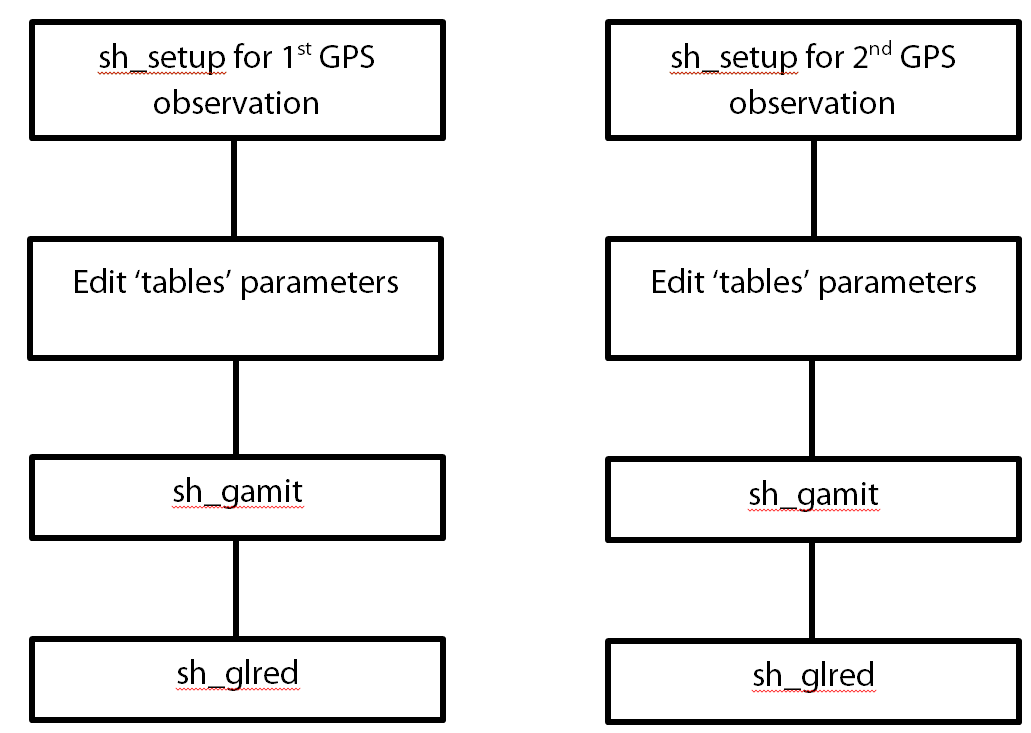This article is continuing on GPS data processing using GAMIT. For reader who want to read previous article, please read this.
Assumed that you already done with your data processing using this step and you have at least more than 1 GPS data observation to combine. To make it clear, I will draw the assumptions as a picture below
Fig.1. GAMIT data processing
The main specific control for this step are :
- The list of sites to be used in defining the reference frame.
- The a priori coordinates for these sites.
for simplicity, user can use IGS station as sites for defining reference frame. It’s due to the assumption that IGS station is most stable station used in the processing. Using this step, reader will gain output of GAMIT/GLOBK processing which contain GPS observation sites and GPS reference sites, and get 3 epoch repeatibilities and velocities.
A. Create new folder.
create 2 new folder under your project folder, namely “h-files” and “h-gamit”. This folder is used to store h-files from global solution (under hfiles folder) and h-files from sh_gamit processing (under hgamit folder).
hint: to make it easy, you can link your h-files from sh_gamit processing which is originally stored in each DOY folder using this command (executed under hgamit folder)
ln -s ../???/h[expt] .
where : expt is the name of the project experiment.
B. Create list of H-file.
Create a list of H-files to be input to GLOBK for repeatabilities. Before that, convert H-file to glb file using this command.
htoglb glbf tables/[expt].svs hgamit/h* for your h-files from gamit processing, and
htoglb glbf tables/[expt].svs hfiles/h* for h-files from global solution.
After that, create list of H-files (under glbf folder) using this command :
ls ../glbf/*.glx > [expt].gdl
where :
expt = name of experiment.
the *.gdl file may optionally contain additional parameters to indicate re-weighting and coupling. To do that, you can append “1.0 +” in the end of every line inside the *.gdl file.
C. Preparing control file.
before execute repeatabilities, don’t forget to copy globk_comb.cmd, glorg_comb.cmd and *.gdl file to GSOLN, and edit those 2 files (globk_com.cmd and glorg_comb.cmd). please refers to GAMIT/GLOBK manual book to help you to edit these files.
In addition, please copy stab_site.global, itrf08.apr, igs08_disc.eq, and pmu.usno from gg/tables to your project directory tables. this step may be vary, because these copies files are depend on your editing in globk_com.cmd and glorg_com.cmd)
D. Processing
To get repeatabilities, please type on your terminal under your project directory
glred 6 globk_com.prt globk_comb.log [expt].gdl globk.cmd
where = [expt] is the name of your *.gdl file.
This command will make globk_comb.org as output file solution for h-file in the *.gdl file. You should check this file for quality and uncertainties to the positions and velocities.
E. Plot result
Use this command for plotting your globk output
sh_plotcrd -f [file *.org] -expt [experiment name] -cols [number of column, type = 1 for single column or 2 for double colomn]
check your ps file to see the output plot of this command. If there are any outliers, they must be dealt with by exclusion or downweighting .
Kyoto, 22 Agustus 2014
Hidayat Panuntun




